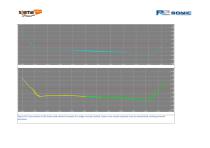
Catalog excerpts

Sonic 2024 Dual Head Survey Summary R2Sonic’s Sonic 2024 has recently been tested in Dual Head mode by Stema Systems mounted on a surface vessel. The Test was performed on a 7 meter survey vessel, with goal to survey the fringes of several Dutch rivers and waterways. Measurements were achieved in water depths ranging from 0.5 to 35 meter. Data-acquisition could easily be done by an off the shelf Laptop with all sensors interfaced via Ethernet and source timing. Maximum achieved swath width was 120 meter at 4-5 meter water depth: >25 times water depth coverage. Comparison with standard survey lines showed the repeatability of the data and absolute deviation between the two sets was less than 10 cm. At normal survey speed, a swath width of over 14x water depth coverage was achievable. An additional benefit of the tilted sensors was the reduced risk of damage as sailing near groins could be avoided. The tilted head enabled measurements close waterline (<0.5 meter from waterline). Introduction With a 160 degree maximal wedge capability the necessity of dual head configuration is in many cases not strictly necessary. There are however situations when the dual head configuration will have a cost effective and risk reducing effect: • • • • Fig 1: 7 m long survey vessel “Karnic” equipped with 2 R2Sonic Sonic 2024, Ixsea Octans G4, Stema Systems GNSS960, Qinsy8.0 Increased hit count and path width in very shallow waters Horizontally focussed beams for sideways detection of groins and structures (risk reduction) Better low angle performance on flat bottom due to better arrangement of receiving array Increased detail by overlapping data To evaluate the technical possibilities and the added value to the survey operations, Stema Systems installed 2 complete Sonic 2024 systems on a small survey vessel for inland and shallow coastal operation. Tests were performed on the River Lek and the Amsterdam-Rhine Channel in the Netherlands. Sonic dual head functionality and advantages The Sonic 2024 has the capability of selecting dual head configuration from the Control software. When the dual head is selected, a second wedge display is enabled and controls such as range, power, pulse length and gain set both sonar heads.
Open the catalog to page 1
Figure 2: Sonic Control Dual Head Wedge Display Other high frequency multibeam echosounders are limited to alternating ping in dual head configuration, which effectively half the ping rate at a given range setting. Depending upon the depth and range selection, a significantly reduced ping rate will provide lower data density when used from a surface vessel. The Sonic 2024 is unique in that simultaneous ping is possible in dual head mode, providing full ping rate at the given range setting by working on different System setup The sonar head heads were placed on a bow mounted frame...
Open the catalog to page 2
Fig 4: Dual Head survey was run on laptop PC with all Fig 5: Required space for 2 SIM boxes is still modest sensors interfaced via Ethernet port Alert Gauges [Description_ [ | RjQ STEMA-GNSS 860 - Position mode outside limit (3 - 3) Fig 6: All sensors on Ethernet Port Fig 7: Combined swath display in Qinsy data acquisition window. Real time control on line up and SV at head. During the tests the systems ran problem free, with minimal processor load. A laptop was clearly sufficient for the task and data routing via a gigabit Ethernet switch proved to be a sound solution. Several test lines...
Open the catalog to page 3
Fig 8: Qloud presentation of 120 meter wide channel of 4-5 meter water depth surveyed in 2 lines at normal survey speed. Horizontal scale lines: 20 m, Vertical scale lines: 1 m In fig 7, two lines at standard survey speed were sufficient to cover the 120 m waterway. The Survey results comply with the NL-geonorm A, which is slightly more stringent than IHO special order. A hit count of minimal 10 validated measurements per square meter was achieved. In the overlapping section the 95% reliability was better than 10 cm. This is evident from the good matching of the lines in fig 8. A 70 meter...
Open the catalog to page 4
Fig 9: Detail of shoreline measurement. The shore section was surveyed in detail at normal survey speed. Valid readings were obtained up to 15 cm below the water level (3.05 m during survey)
Open the catalog to page 5
Figure 10: Cross-section of 120 meter wide channel surveyed in a single run (top section). Lower cross-section separate runs are overprinted, showing minimal
Open the catalog to page 6All R2 Sonic LLC catalogs and brochures
-
Sonic™-V Series
2 Pages


